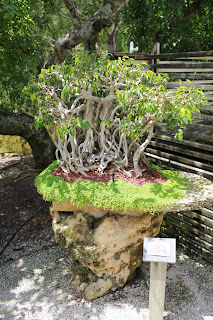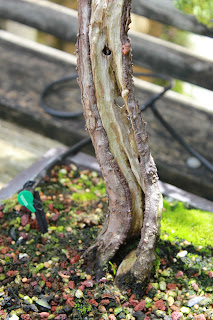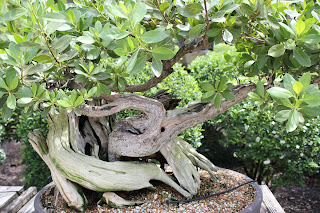Welcome
As is the gardener, such is the garden!!
The trouble with gardening is that it does not remain an avocation, it becomes an obsession. - Phyllis McGinley
Monday, August 29, 2011
Saturday, August 27, 2011
The History of the Pomegranate

The many-seeded fruit of the pomegranate tree (Punica granatum), native to the Near East and tropical Africa, is one of the oldest Semitic symbols of life, fertility and abundance. The pomegranate, along with wheat and the grape, was regarded as one of the prime attributes of Ibritz, the Hittite god of agriculture. It was embroidered at the hem of Aaron's sacred robes and adorned the official vestments of the priest-kings of ancient Persia. The capitals and pillars of the Temple of Solomon were covered with carved pomegranates. Pomegranates were served at the marriage banquets of ancient Assyria and Babylonia as a symbol of love and fecundity.
When the pomegranate traveled from Asia Minor to the Far East, its symbolic meaning accompanied it. At Oriental weddings, seeds of the pomegranate were offered to the guests and when the newly-weds entered their bedchamber, pomegranates were thrown to the floor of the bursting fruits strewed their seeds all over the room, signifying that the marriage should be happy and blessed with many children. When the Moors conquered Spain about 800 A.D., they introduced the pomegranate into the Iberian peninsula and the fruit became the emblem of Granada, whose name was derived from it.

Catherine of Aragon (1485-1536), the first wife of Henry VIII, wore the Spanish emblem of the pomegranate, and the Oriental fruit became the badge of their daughter, Mary Tudor (1516-1558), Queen of England.
Presumably, the pomegranate was introduced into the new world by the early Spanish colonists and has since been commonly cultivated in gardens ranging from warmer sections of the USA to Chile. Small commercial plantings have been made in California. Though pomegranates will grow in a wide range of climates, good fruit is produced only where high temperature and dry atmosphere accompany the ripening period.
Varieties cultivated in the USA are the Wonderful, the Paper-Shell, and the Spanish Ruby.
 The name of the pomegranate was derived from the Latin pomum (apple) and granatum (with seeds). When the explosive shell that strewed metal particles over a wide area was invented, the French, mindful of the seed-scattering characteristics of the pomegranate, called it granade, and the special regiments, founded in 1791, who launched these new weapons, were called granadiers.
The name of the pomegranate was derived from the Latin pomum (apple) and granatum (with seeds). When the explosive shell that strewed metal particles over a wide area was invented, the French, mindful of the seed-scattering characteristics of the pomegranate, called it granade, and the special regiments, founded in 1791, who launched these new weapons, were called granadiers. In folk medicine, the fruit's astringent properties have been used to treat various ailments (cuts, sore throats, tapeworms, dysentery, and gum disease). Pomegranate juice is marketed in the United States as a major source of antioxidant nutrients that protect against heart disease and other ailments. Recent research has focused on its potential use as a treatment for cardiovascular disease, diabetes, and various forms of cancer.

Pomegranates are a good source of vitamin C, providing between 10-20% of the recommended daily allowance according to one source and up to 40% according to another. The potent antioxidant properties of the fruit have been attributed to its high content of soluble polyphenols. When tested in vitro on normal and colon-cancer cell lines, the juice was found to have superior antioxidant, antiproliferative, and proapoptotic effects compared with single purified active ingredients, probably the result of synergistic actions among the fruit's multiple compounds. Studies have shown that the antioxidant activity of the pomegranate flowers yielded activity two to three times the antioxidant potency of tea or red wine.

Pomegranates are a good source of vitamin C, providing between 10-20% of the recommended daily allowance according to one source and up to 40% according to another. The potent antioxidant properties of the fruit have been attributed to its high content of soluble polyphenols. When tested in vitro on normal and colon-cancer cell lines, the juice was found to have superior antioxidant, antiproliferative, and proapoptotic effects compared with single purified active ingredients, probably the result of synergistic actions among the fruit's multiple compounds. Studies have shown that the antioxidant activity of the pomegranate flowers yielded activity two to three times the antioxidant potency of tea or red wine.
In studies of the fruit's anticancer effects, pomegranate fruit extract (PFE) has been found to be chemopreventive in mouse mammary organ culture and in human breast cancer cells in vitro. Researchers at the University of Wisconsin in Madison found that PFE significantly reduced serum prostate-specific antigen levels and inhibited proliferation of aggressive human prostate cancer cells in athymic mice. Pomegranate extracts have exerted antiproliferative, antiestrogenic, and proapoptotic actions on leukemia cells as well as breast- and prostate-cancer cells.
 Its juice may be cardioprotective, reducing risk factors (such as cholesterol accumulation, foam-cell formation in macrophages, and oxidized low-density lipoprotein [LDL]) without affecting native LDL.
Its juice may be cardioprotective, reducing risk factors (such as cholesterol accumulation, foam-cell formation in macrophages, and oxidized low-density lipoprotein [LDL]) without affecting native LDL. In a randomized, double-blinded, placebo-controlled study at the Preventive Medicine Research Institute in Sausalito, CA, pomegranate juice drinkers with coronary artery disease had a 17% improvement in blood flow compared with an 18% worsening in the control group. The study team concluded that the antioxidants in the juice may help prevent the formation of fatty deposits on artery walls. Australian researchers found that pomegranate flower extract reduced factors (hyperglycemia, hyperlipidemia, and a fatty heart) that can result in increased cardiac-impairing fibrosis in patients with type 2 diabetes.
 Other studies have shown the benefits of pomegranate in promoting neurologic health, maintaining joint integrity and function, exhibiting estrogenic properties, blocking herpes simplex virus replication and adsorption, enhancing immune function, treating periodontal disease, enhancing the activity of antibiotics used to treat methicillin-resistant and methicillin-sensitive Staphylococcus aureus infections, and preventing smooth muscle dysfunction and fibrosis in erectile dysfunction.
Other studies have shown the benefits of pomegranate in promoting neurologic health, maintaining joint integrity and function, exhibiting estrogenic properties, blocking herpes simplex virus replication and adsorption, enhancing immune function, treating periodontal disease, enhancing the activity of antibiotics used to treat methicillin-resistant and methicillin-sensitive Staphylococcus aureus infections, and preventing smooth muscle dysfunction and fibrosis in erectile dysfunction. In Ayurvedic medicine, the astringent properties of pomegranates are linked with bone and cartilage build-up; in the cosmetic arena, fruit-peel extract has been shown to stimulate a type of procollagen synthesis and inhibit a dermal degeneration process.The antioxidant, immune-boosting, and anticarcinogenic properties of the pomegranate, offers multiple potential medical applications.
In Ayurvedic medicine, the astringent properties of pomegranates are linked with bone and cartilage build-up; in the cosmetic arena, fruit-peel extract has been shown to stimulate a type of procollagen synthesis and inhibit a dermal degeneration process.The antioxidant, immune-boosting, and anticarcinogenic properties of the pomegranate, offers multiple potential medical applications.Thanks Shari Henson for your contribution with this post.
Tuesday, August 23, 2011
What does hydroponics mean?

This capacity for divorcing the cultivation of flowers, vegetables, fruits and grains from the soil has profound implications for the development of horticulture and farming. In short, it means that mankind is no longer solely dependent on the land for sustenance and the satisfaction of natural desires for a beautiful environment, because gardeners and farmers can now produce lovely flowers and raise fine crops without any soil in almost any place they may wish.
Given a minimum supply of water, hydroponic units, both small and large, may be set up in towns and cities, for the enjoyment and use of urban populations, while people living in deserts or barren regions can raise quantities of attractive and healthy plants even under the very infertile conditions common in such areas.
 Apart from these general considerations hydroponics also offers certain important advantages to the individual gardener or householder, including better quality plants, quicker growth, much saving of time and labour (with the elimination of troublesome tasks like digging, weeding and manuring), lower costs, complete absence of dirt and smells, extremely consistent results and year-round attractive displays of blooms or quantities of fresh green-stuff in the home.
Apart from these general considerations hydroponics also offers certain important advantages to the individual gardener or householder, including better quality plants, quicker growth, much saving of time and labour (with the elimination of troublesome tasks like digging, weeding and manuring), lower costs, complete absence of dirt and smells, extremely consistent results and year-round attractive displays of blooms or quantities of fresh green-stuff in the home.The new simple methods, which are described in this book, make it possible for anyone to raise first-class plants without difficulty, even in the most congested surroundings. Housewives, flat and apartment dwellers, backyard or window-box gardeners, or those possessing roof space, indeed amateurs of every type, in any land, can now use hydroponics to brighten up their daily lives.
How a plant grows in hydroponics?
 Hydroponics is generally defined in modern encyclopedias and dictionaries as the science of growing plants without using soil by feeding them on solutions of water and mineral salts, instead of relying upon the traditional methods of cultivating the earth which most gardeners and farmers still continue to do in order to raise crops.
Hydroponics is generally defined in modern encyclopedias and dictionaries as the science of growing plants without using soil by feeding them on solutions of water and mineral salts, instead of relying upon the traditional methods of cultivating the earth which most gardeners and farmers still continue to do in order to raise crops.However, because such a description could sound a little complicated let us begin by thinking in simpler terms.
It is not always realized that hydroponics may be employed in numerous ways, ranging from the large scale production of commercial foodstuffs (flowers and fruits, through medium-sized office and community growing units, right down to smaller lots of colorful home blooms and indoor plants, or tasty vegetables and succulent salads for the household, or as a family hobby. This striking versatility of soilless culture, combined with the excellent results that can be obtained in all kinds of places, has made the system ideal for widely differing conditions. In fact, hydroponic gardening can be easier and more pleasant to do than ordinary soil gardening.

Monday, August 22, 2011
Subscribe to:
Comments (Atom)

































































